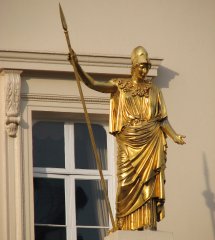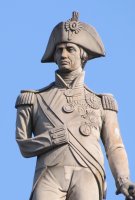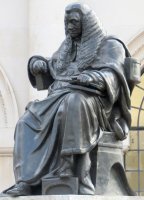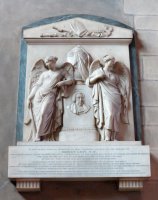Edward Hodges Baily RA (1788-1867)
E. H. Baily, sculptor of the Nelson on Nelson's Column, also made a variety of significant portrait statues and ideal works in London and elsewhere.
Nelson, at the top of his column.
Edward Hodges Baily was a native of Bristol, the son of a noted carver of ships' figure-heads. He showed early promise in carving and wax modelling, and in 1807 entered the studio of Flaxman, working mostly on ideal subjects. He then became chief modeller to Rundell and Bridge, a leading gold and silversmiths (he retained this connection for 25 years), and also was a student at the Royal Academy Schools from 1809. From the beginning he was successful there, and by 1811 won a Royal Academy gold medal with a work entitled 'Rescue of Ascestis from Orcus by Hercules'. He exhibited much at the Academy, and was elected ARA in 1817, and full RA in 1821, retiring in 1862.
Judge Tindal, Chelmsford.
Baily maintained a continuing production of ideal works, including Classical allegorical and domestic groupings such as of the 'Mother and Child' type. He favoured an idealised slightly over-sweet style for these latter, working in white marble. The figure that made his reputation was Eve at the Fountain, shown at the Academy in 1818. This work is now at Bristol, with later versions elsewhere, and was further popularised through engravings and a Parian ware figure by Minton. Among other works in similar vein we can mention Girl preparing for the bath, The Morning Star, Una and the Lion and Sleeping Nymph.
However, much, perhaps most of Baily's works consisted of portrait busts and statues. Although his imaginary and ideal works are very classical, Baily did not generally attempt to give his modern portrait subjects a classical look with heavy drapes, long cloaks and so forth, as so many of his contemporaries did. However, a characteristic of his sculpture is the understated pose, giving a sense of stillness or repose to his subjects, which evokes a spirit of the classical ideal.
Baily also made a fairly large number of church monuments, though nowhere near the volume of his teacher, Flaxman. His monuments include some very much in Flaxman's style with flying angels in diaphanous robes (a particularly charming one is to Eliza Mortimer, d.1826, in St Martin's Church, Exeter). Others which I have seen are with mourning girls leaning against tombs, always a popular theme. Baily also made a number of panel monuments with portrait medallions, a nice example on this website being shown on the page for St John the Evangelist Church, Stoke-next-Guildford, Surrey.
Typical church monument by E.H. Baily.
In London, apart from the statue of Nelson in Trafalgar Square, Baily made much of the sculpture for Marble Arch, some of the exterior work on Buckingham Palace, and various monuments in St Pauls and Westminster Abbey. He also has one work near that other column, for the Duke of York, in Waterloo Place - it is the excellent Pallas Athena on the portico of the Athenium. In Chelmsford, County town of Essex, is Baily's Chief Justice Tindal, in a square of the same name. A statue of Sir Robert Peel is in Bury, and his Earl Grey is on another column, in Newcastle (see this page). Further work is in the Bristol gallery, and in the Cathedral there. Among works abroad by Baily are Sir Richard Bourke for Sydney, Australia, and Sir Charles Metcalfe for Kingston, Jamaica.
During his long career, a variety of significant sculptors were students to Baily or assistants in his studio, including William Theed the Younger, John Durham, William Calder Marshall, E. B. Stephens and E. Davis. He had 8 surviving children, and one daughter married his student Edgar George Papworth (Sr), so that Baily had at least one grandson who was a sculptor, Edgar George Papworth (Jr).



